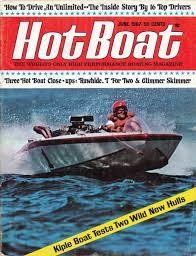The heat is transferred from the internal components via the oil that is splashed on the inside casting area.
MerCruiser's original Bravo drive did not have an internal reservoir. In the old days, the #4 Speedmasters had a transom plate that housed a built-in reservoir, which allowed for expansion of oil under heavy load conditions. At length, MerCruiser realized that with the increase in load came an increase of heat temperature. When the temperature increases, there is a greater expansion of oil and, thus, a greater risk of blowing seals as the pressure increases inside the enclosed housing. A fix for this problem was to put a reservoir inside the transom like they did on their race applications. The outdrive recovery system takes the expanded oil from the top, through the transfer tube (located about 2.5 inches below the top bearing cap of the drive), allowing for an air pocket to remain at the top where splash oil is produced. Once the heated and expanded oil is in the recovery system, it will remain there until the oil temperature has diminished and then will transfer back into the drive to maintain the proper oil level. Its very similar to what a closed cooling system does on your car radiator. The transfer of heat is quite evident on the top bearing cap area, more so because it is aerated oil being splashed against the aluminum housing. The gearcase is not dragging in the water like the lower unit, where the propeller is submerged in water. This is more noticeable to those who don't use drive showers. They may also notice the tremendous amount of white alkali buildup on the upper end of the drive. This is due to splashed water hitting the top of the drive, which is hot enough to cause quick evaporation and leave hard-water particles. This is similar to hard-water spots on your home shower, and they're just as difficult to remove. It's not very pleasant to look at.
SOLUTION TO THE PROBLEM
One way to cool the outdrive, as well as prevent those unsightly alkali spots is to install a drive shower to the outdrive. The standard drive showers have one outlet at the top that sprays water on top of the outdrive. This splash system diminishes heat in the unit, but how much heat does it really remove? To find the answer, we turned to the Multiport Drive Shower, manufactured by Simrek Corporation of Henrietta, New York. The Multiport Drive Shower is a stainless steel tube built with holes in the bottom and cut at a 45-degree angle. By dragging this unit off the cavitation plate, water can be forced to travel up the tube, then flow through the outlets on the top end, flooding the outdrive. This flooding removes the temperature from the drive unit.
HOT BOAT performed tests of the Multiport Drive Shower® on three different boats. The first was a 26 Howard Cat with a HP500 EFI package and a stock Bravo drive with a 1:36 gear ratio. The Bravo is a sturdy and stout unit, which we knew would hold up when we increased temperature and used large-pitched propellers. With the combination of gear prop and engine torque, the unit is asked to do a remarkable job by keeping the heat down to a controllable minimum, which it cannot do on its own. High power and stock applications, due to increased load will also experience an increase of heat temperature in the outdrive. Increased load could be defined as a number of things: more people in the boat, a full fuel tank, anchors, ice chests and other amenities that boaters like to have onboard. And increased load means more temperature in the outdrive due to the increased energy it takes to push the boat. In our tests, we found that one particular drive shower design does not lend itself to all applications. The Multiport Drive Shower® system gave us the opportunity to expand on what we believed could happen on some applications. The basic design of the drive shower is a piece of stainless steel tube that is affixed to the cavitation plate and is bent to contour the design of the outdrive with outlets on the top side and outlets on the side area that dump water onto the top bearing cap and side area of the outdrive. The end that is submerged in the water has an opening cut at a 45- degree angle. After installing and testing the drive shower on the beautiful 26 Howard tunnel boat, we were surprised by the relatively minimal results. We only achieved a drop in temperature of 18 degrees in our oil, a far cry from the results we expected. After completing this test, we spoke with Paul Kermis, president of Simrek Corporation, about our test results. He informed us that the wrong drive shower had been sent for our application, and he would immediately ship out the correct drive shower. The new drive shower, he said, would have more depth below the ventilating plate. When we began our testing, we hadn't realized there would be-or should be- different applications for different styles of boats. After all, the drives are all the same. But we learned that the length of the tube below the cavitation plate was too short for a tunnel boat. We didn't know that by trimming the drive out in the upper trim areas, we created a cavitation in the drive shower that produced minimal water pressure on top. This also became apparent when we tested and photographed a vee-bottom application. The water comes off the vee-bottom boat differently than off a fla pad in the center of the tunnel boat we tested.
After receiving a replacement unit, we set out to perform a second test. Unfortunately, the 26 Howard that we used for our first test was no longer available, having moved up north with its new owner. So we asked another Lake Castaic area boat manufacturer to participate in our second test. High Torque Marine was receptive to our request and provided us with a 24SR with a blower package and a stock Bravo drive (1:36 gear ratio). We then installed and tested the new Multiport Drive Shower® designed for a tunnel boat. The replaced drive shower was updated with a longer water pickup. When we performed the test, the oil temperature immediately dropped 32 degrees in the unit, but the unit didn't want to stabilize a temperature drop. And although the drop of 32 degrees was a tremendous improvement over the 18 degrees of the first test, it still didn't compare to the 50-degree drop in temperature the manufacturer told us that many of their customers had achieved. Since their customers don't use the same testing equipment as HOT BOAT, We kept an open mind. After we saw that we took 32 degrees out of the unit, we wanted to get a visualization of what was happening at the back of the boat. While the boat was cruising at 40-45 mph, we lay over the back hatch and physically looked to see what the water was doing as we trimmed the drive in and out. We wanted to know what was happening to the water once it was distributed through the holes on top of the drive and to find out what kind of water pressure we could accumulate (as well as what kind of flow we had). Interestingly, the drive shower with the 45-degree-angle cut had water pressure, but it wasn't impressive. It was then that we decided we would put on a Gaffrig water pressure gauge donated to us by Livorsi Marine.
As we continued to lie over the back hatch, we saw that the water came out the exit holes on the top of the drive and hit the drive. Then it appeared that the water recoiled. It would be like taking a garden hose, making a pointed spray and putting it close to the ground: The water hits the ground and rebounds upward. With the forward movement of the boat, we were not getting any extra water running down the side of the drive from the top, which did not provide the amount of cooling we were looking for.
Once again, I discussed our results with Paul Kermis. Based on my observations, I suggested that instead of having the shower drive pickup area cut at a 45-degree angle, we might add a solid tube (cap) with a hole just in the frontal area. Then, when we trimmed the drive out, we could still get the same amount of water pressure without creating a cavitation effect on the driveshaft. Paul agreed and set out to make the modification. We would need to test the Multiport Drive Shower again.
DRIVE SHOWER MOD RESULTS
When we added the cap to the end of the drive shower pickup and took the boat out for another test run, the first thing we noticed was the stabilization of the oil temperature while in cruise mode. We noticed that at all rpm ranges, there would be an increase, yet the oil temperature stabilized within one degree. The consistent temperature was an improvement in itself. We were unable to do this with the stock unit with the 45-degree cut on the water pickup. On our prior test, when we cruised at 3,500 rpm, the temperature would fluctuate up one or two degrees. The longer we ran, the more it fluctuated. After this test, we repeated the process of watching over the back of the boat to see what the increase of water pressure would be. It was incredible, the pressure increased about 75%. There was water everywhere. It was running over and around the drive. And with the better water flow, we realized stabilization of temperature. As we increased the rpm, we found that the drive shower substantially dropped the temperature. We were able to take 43 degrees of oil temperature from the baseline of our tunnel boat. This was 43 degrees at 100 mph. Steve from High Torque Marine suggested that increasing the rpm in 500 rpm increments through the whole test, reaching 4,000 rpm and 80 mph, then stopping and increasing to 4,500 rpm, then to 5,000 rpm and eventually reaching 100 mph, was hard on the unit. But all through the tests, the decrease of 43 degrees remained and stabilized under load conditions.
FROM TUNNEL TO VEE
Pleased with our testing results on the tunnel boat, our next test of the drive shower was a vee-bottom. We wanted to see if we could reach the 50 degree decrease Simrek said others had reached. Simrek also advised that the majority of the boats tested with these results were vee-bottoms. We took a 25 Sonic vee with a stock big block and Bravo drive (1:50 gear ratio) and duplicated the test. We followed the same procedure as before: testing the boat without the drive shower and establishing a baseline temperature. We did two different tests, one with the stock drive shower and one with the tip extension. The stock drive shower on the vee-bottom had a definite and positive effect compared to the test on the tunnel boat. It took out over 40 degrees in the cruising mode. When we tested the vee-bottom with the tip extension, we took out 48.2 degrees, but we still didn't reach the 50 degrees we were looking for. We felt the 48.2 degrees was as close as we would get with HOT BOAT's test equipment. Although we didn't get a decrease of 50 degrees when using the extension tip, we did experience the same stabilization as in the tunnel boat. Our tests seemed to indicate that the new tip design worked better for the boats we tested than the 45-degree angle cut-type tip. This is not to say that all boats running the 45-degree-angle tip won't have good results; it simply means the boats we tested did better with a different tip design, including consistent stabilization in the cruising mode. As I stated before, this is an improvement in itself. Simrek Corporation manufactures two different styles of drive showers, or halos. The one we tested was the Summit design. It has seven dump ports: three on top and two on each side. Simrek also offers a performance model, which has eleven dumps (three on the front and four on each side). The Summit design, which fits most applications of standard drives and steering systems, works extremely well. We were able to get a temperature decrease of 48.2 degrees, which was very close to the decrease stated by the manufacturer. Being able to take out almost 50 degrees is nothing short of remarkable. This means that the oil doesn't break down as fast. Anytime we can take heat out of a product, under load conditions, we're going to extend the life of the product. Heat is death. The Multiport Drive Shower works as well as it's advertised. But, in my opinion, one size does not fit all. You can run into problems on tunnel boats if the depth of the unit is not correct or the water pickup hole is not in the right location. The majority of the drives do not run a temperature gauge, so a user may not know if they're getting the full benefit of the drive shower.
The next test we'll be doing will include the modification for a pressure gauge so we can put different tips on the bottom of the unit. This will enable us to see how much pressure we actually gain and how much temperature drops off by trimming the drive out to the full maximum as we attempt to air out the boat and achieve maximum speed. We are looking forward to doing these modifications, which, in the end, will benefit all those who are looking for ways to improve the running of their boat.
Reprinted with permission from Hot Boat Magazine
This article by Jim Wilkes appeared in the April 2000 issue of Hot Boat
Magazine. The pictures that accompany the article have been removed in order to
save space, though the content remains unaltered. Please refer to the magazine
for the article as it was published in its entirety.


